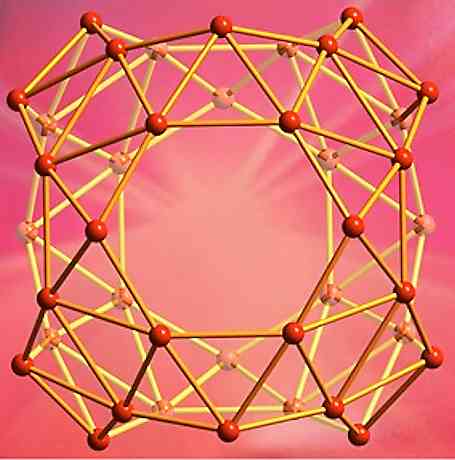
Carbon buckyballs (or fullerenes) were discovered several years ago and hold the promise of hydrogen storage. Now, recently researchers at Brown University have discovered boron buckyballs or as they call them borospherenes that may hold hydrogen atoms as well.
According to Brown, “The discovery of buckyballs – soccer-ball-shaped molecules of carbon – helped usher in the nanotechnology era. Now, Lai-Sheng Wang’s research group and colleagues from China have shown that boron, carbon’s neighbor on the periodic table, can form a cage-like molecule similar to the buckyball. Until now, such a boron structure had only been a theoretical speculation. The researchers dubbed their newfound nanostructure ‘borospherene’ …
“…As for possible uses for borospherene, it’s a little too early to tell, Wang says. One possibility, he points out, could be hydrogen storage. Because of the electron deficiency of boron, borospherene would likely bond well with hydrogen. So tiny boron cages could serve as safe houses for hydrogen molecules.”
In March of 2008, I had talked about how Rice University was working on developing carbon buckyballs or nanocages that could hold and release hydrogen atoms.
The U. S. Department of Energy (DOE) has outlined that for hydrogen cars and infrastructure to grow and develop, the storage of H2 on a large scale must be addressed. As a consequence many researchers are going buckyballs to the wall to make this happen.
Will have to look at the old periodic table and compare the electron affinity of carbon to boron. You want a high electron affinity, but you also want an element that is readily available and if at all possible non toxic. Gotta remember some chemistry…
Can boron be incorporated into the lining of H2 tanks to increase the storage capacity and/or reduce leaking?
Another option is storing ammonia instead of hydrogen gas to avoid losses. Reform the ammonia as needed to fill hydrogen based vehicles. Problem with ammonia, especially the anhydrous variety, is that a leak can be very dangerous to people. A thought is to have a double hull tank where the inner tank contains ammonia and the outer tank is filled with water. If the ammonia is bubbled through water, it will be less dangerous to people. Question, is it easier to strip hydrogen from ammonia mixed with water or just water? Another advantage of storing ammonia is that ammonia based fuel cells can use ammonia directly where you could support both H2 gas based FCVs and Ammonia based FCVs. If gasoline is dispensed, mix in some ammonia instead of ethanol for vehicles that are tuned to burn the ammonia.
I think ammonia, hydrated for safety reasons, may be the ultimate way to go. Existing fuel trucks can transport ammonia. If I’m not mistaken, ammonia can be stored as a liquid at low pressure compared to hydrogen. I am not sure how energy intensive if you have a source of nitrogen and a source of hydrogen producing ammonia is. Hydrogen can be extracted from water, but nobody knows how to store it in large quantities cheaply and in a small space.
Ammonia, if not the best long term strategy, could work in the short term quite well. Ammonia if cars/trucks/suvs are tuned properly can be added to gasoline. Ammonia can be burned directly. Ammonia can be used in a special type of fuel cell also. Ammonia seems like a good transition fuel.